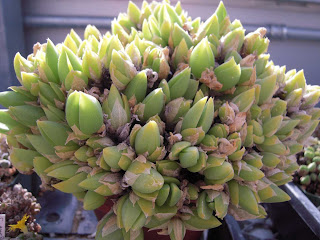South Africa has a rich tradition of using native plants in folk medicines. One of the most famous examples is Kougoed or Kanna, the fermented and dried leaves of Sceletium tortuosum, which is supposed to be effective against a huge range of maladies. Like various other members of the family Aizoaceae (the mesembs or ice plants), Sceletium tissues contain mesembrine and other alkaloids, which are known to have psychoactive properties. The plant has been subject to a certain amount of legitimate pharmacological research, and also--as an internet search will quickly show--a whole lot of enthusiastic amateur experimentation and attempts at commercialization.
The genus name Sceletium was inspired by the skeletal venation that is visible in old, dried leaves. The dead leaves of S. tortuosum persist for some time, and during the dry season act as protective scales over the living shoot tips. Some authors place the eight or so accepted species of Sceletium within the larger genus Mesembryanthemum.
 |
| Sceletium tortuosum at Kruisrivier, in the Little Karoo in August (late winter). |
Sceletium tortuosum is very broadly distributed in the arid parts of western and southern South Africa. Its habitat is primarily in a winter-rainfall climate, but edges into summer-rain areas in the east. Cultivated plants grow most vigorously in winter, but can be tempted into a certain level of summer activity if water is available. Possibly the preferred seasonality of growth depends on the collection locality; I would expect that plants from the west in Namaqualand would be more strongly inclined towards winter growth. In cultivation, plants look best if given as much sun as possible, and quickly become thin, scraggly and unattractive if light levels are inadequate. Otherwise, Sceletium presents no particular problems in cultivation, and is easily propagated from stem cuttings.
References:
Chesselet, P. 2005. Sceletium
tortuosum PlantZAfrica page. http://www.plantzafrica.com/plantqrs/scelettort.htm
Gerbaulet, M. 2001. Sceletium.
Illustrated Handbook of Succulent
Plants, Aizoaceae F-Z, Springer-Verlag, Berlin, Heidelberg, New York.

No comments:
Post a Comment